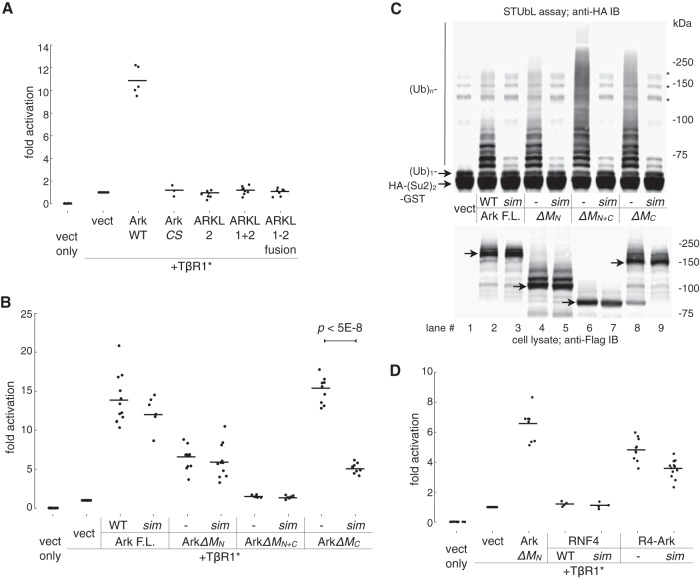FIG 4.
The M domain of Arkadia is essential for function. (A) The activities of Arkadia and ARKL1/ARKL2 were compared in a reporter assay for the activation of a TGFβ-responsive promoter. Transient transfection of plasmid was carried out as indicated; luciferase assay was performed on 293T cell lysates 2 days after transfection. Luciferase activity is shown as fold activation relative to the activity obtained with TβR1* alone. TβR1*, constitutively active mutant of TGFβ type I receptor (also known as ALK5*, with a T204D mutation in the kinase domain); CS, Arkadia RING domain mutant C966S. All data points from multiple independent experiments are plotted as dots slightly scattered along the x axis, with horizontal lines showing the average values. (B) Activities of Arkadia and its mutants. F.L., full-length Arkadia; sim, Arkadia sim13m mutant. M domain deletion mutants are as described in the legend to Fig. 3. Transfection and luciferase assay were conducted as described for panel A. The significance of difference (P value) between the activities of ArkΔMC and its corresponding sim mutant was estimated based on a paired, one-tailed Student's t test. (C) SUMO-targeted ubiquitin ligase activity of Arkadia and its mutants. The assay was carried out essentially as described in the legend to Fig. 1A. Various forms of Flag-tagged Arkadia (as indicated) were immunoprecipitated from the lysates of transfected 293T cells and subjected to ubiquitylation assay using free ubiquitin (Ub) and an HA-(SUMO2)2-GST [HA-(Su2)2-GST] fusion protein as substrates. Top, anti-HA antibody immunoblot showing the modification of HA-(SUMO2)2-GST as a result of the in vitro STUbL activity of Arkadia proteins. *, nonspecific bands, likely high-molecular-mass aggregates of HA-(SUMO2)2-GST. Bottom, an anti-Flag antibody immunoblot showing the expression of Arkadia proteins in the cell lysates prior to immunoprecipitation (arrows are pointing at the base forms of Arkadia proteins). (D) Activity of an RNF4-Arkadia fusion protein, R4-Ark, against the TGFβ-responsive promoter. R4-Ark is a fusion of the N-terminal 125 residues of RNF4 (RNF4 1 to 125) and the C-terminal 256 residues of Arkadia (Arkadia 726 to 981). sim, sim23m in the RNF4 SUMO-binding domain. Data points are plotted as described for panels A and B.

